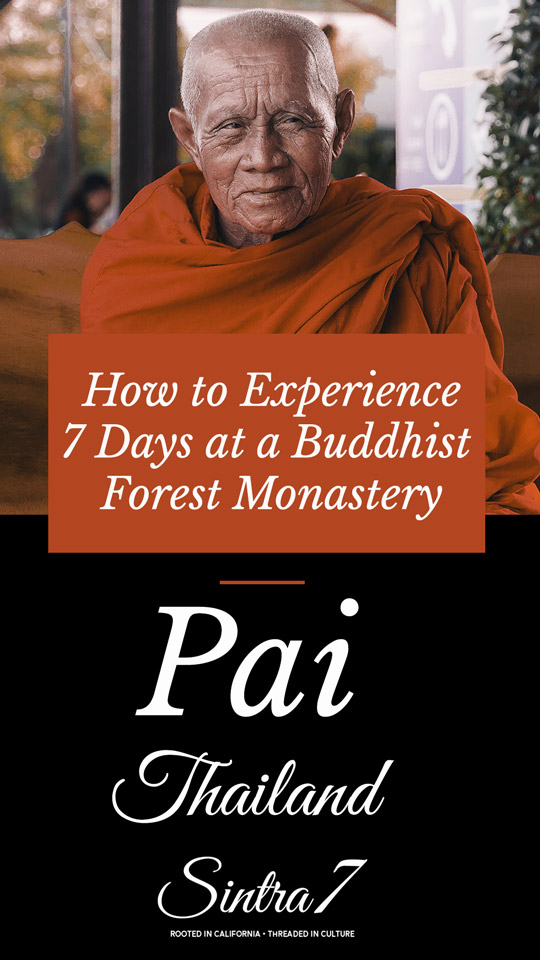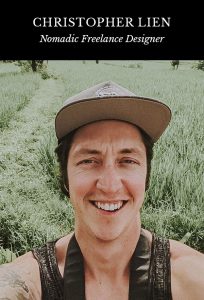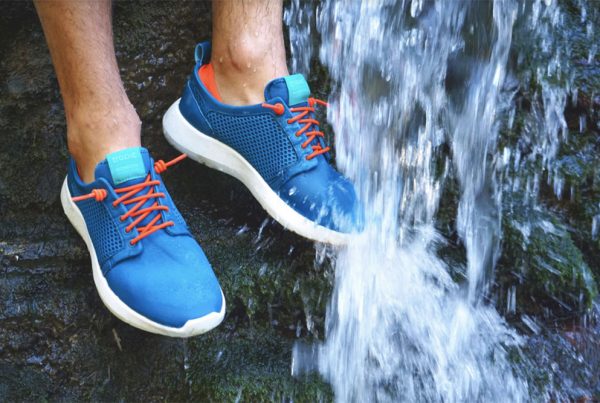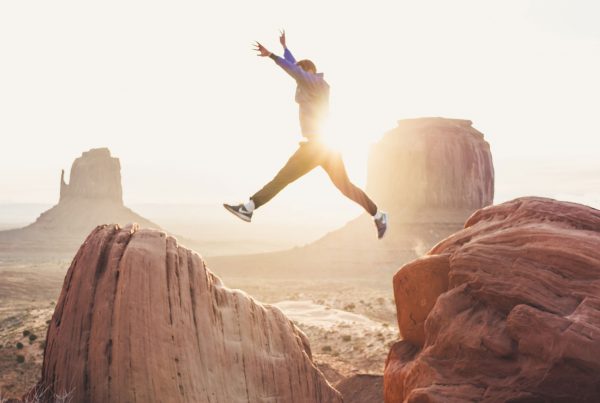When your phone dies, what emotions do you feel!?
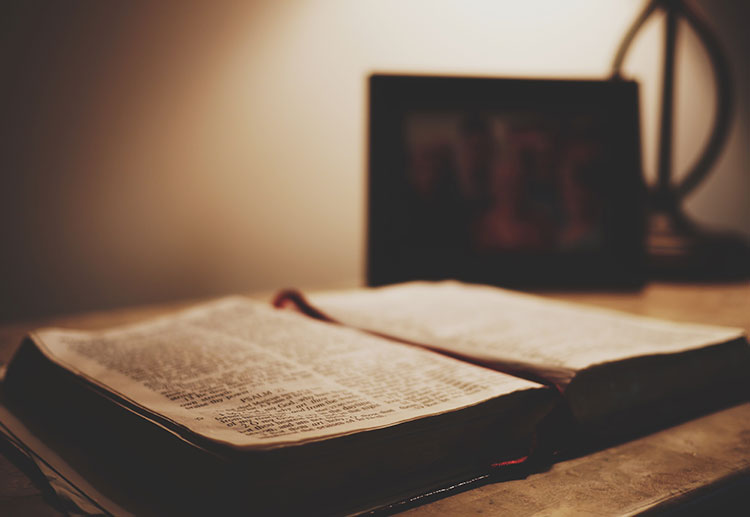
Photo by Aaron Burden on Unsplash
***Since I did a digital detox during my time at the monastery, all photos are courtesy of the talented photographers at Unsplash
The Monastery
Off the Mae Hong Son-Pai highway, Mae Suya district, Mae Hong Son
T: (081) 031 3326
[email protected]
http://watpatamwua.com/
Things to Know before you Go
- The Monastery provides accommodation and 2 meals a day free of charge. They have a donation box at the new Dhamma Hall where you can leave a donation on your way out of the monastery.
- The monastery provided white clothing that you will wear for the duration of your stay. Some monasteries will ask you to bring your white clothing.
- They have a limited amount of alarm clocks. No phones are not strictly enforced but highly recommended for a more authentic experience. Buy a cheap alarm clock before you arrive. I didn’t and the one they gave me didn’t work. I used my internal alarm clock, more about that later in this post.
- You are required to attend all parts of the daily routine of the monks. This is not a freeloader zone.
- Remaining silent is a choice. If you choose to which I would highly recommend, there are name tags that say “happily silent” – at the check-in area.
- There is not much guidance once you are checked in. My advice would be to follow the others, learn quickly, and be easy on yourself. Mistakes will be made, it’s part of the experience.
- The monastery does not require you to request or reserve your stay before arrival. You can come and go as you please.
( This was one of the main reasons I chose to make the journey here from Pai. Being a solo traveler, I sometimes don’t have a plan for the following week. Having a flexible time to arrive and leave the monastery is great. )
Day 1
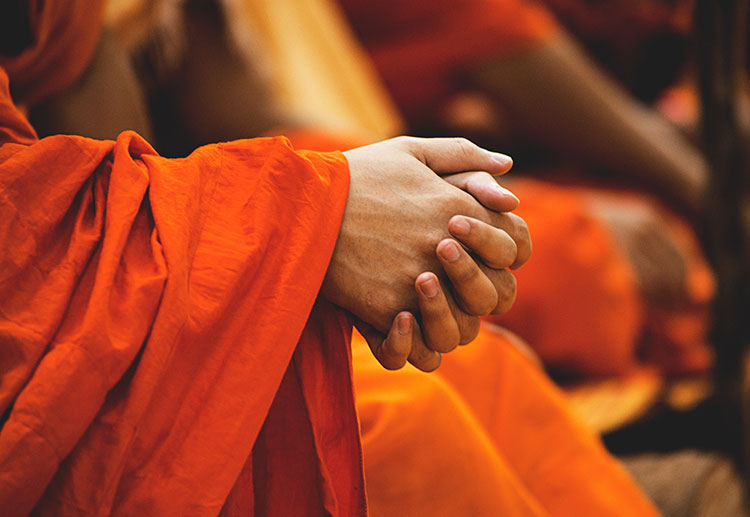
Photo by Peter Hershey on Unsplash
I arrived at the monastery around 2 PM today. It is a peaceful and tranquil place. As I entered the main meditation hall, the monks and other guests were deep in an afternoon meditation. I decided to explore the monastery grounds and a young man, Label, spotted me walking about and waived me over. He had just checked in as well but was already in the all-white attire that was to become our clothing for the duration of the stay. We said a few words and finding that we both planned to go full silent that evening, we acknowledge our last couple words to each other.
Two Teachers in One Week
1st Meditation Recap
Day 2
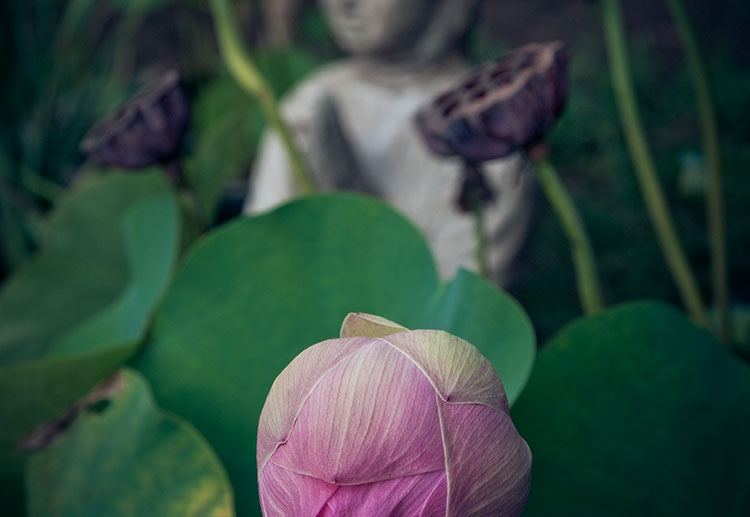
Photo by Sarah Ball on Unsplash
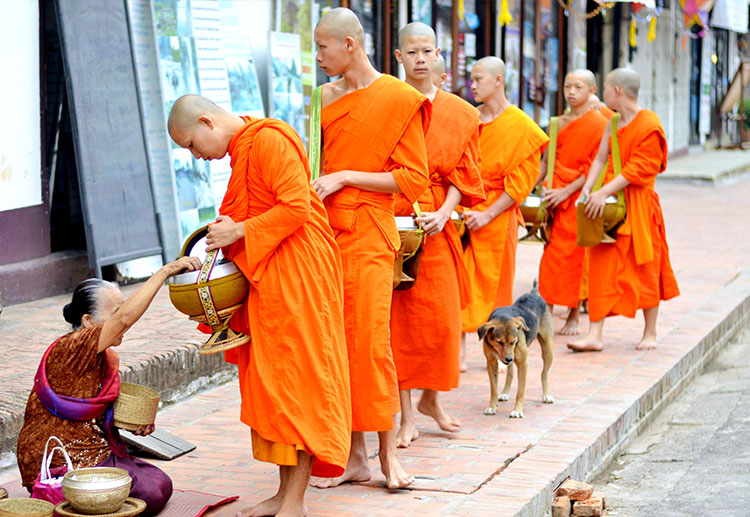
Photo by Laurentiu Morariu on Unsplash
Morning Meditation
Walking Meditation and Evening Meditation
Day 3

Photo by Orkhan Farmanli on Unsplash
Morning Meditation
In breath ( Bha ) —> Out breath ( Dho )
Walking Meditation and Afternoon Meditation
According the monk , Vipassana can be done in a group setting and involves practicing being the knower / observer of your feelings, emotions, and thoughts. Summertime is best practiced in solitude and involves focusing on one object ( most commonly breath ) and keeping a mindful concentration on that object for a long period of time. Summertime involves a fasting of water and food.
Evening Chant and Night Meditation
Tonight would become my breaking point
” I AM ENOUGH. JUST AS I AM. I AM ENOUGH. The universe loves me and wants me to be happy. I am enough. I am just a soul in a body. That is all I need to be.
Day 4
Tapping into the radio frequencies and circadian rhythms, We can know when to do something, or what people yearn for at a specific time.
Within oneness, there is only abundance. Within the flow, it’s all we know.
With a full belly from breakfast, it’s now time for the monk’s morning discussion. One take away from the morning talk that I would like to share with you :
Do not give the remote control to other things. Stay in the driver’s seat…stay connected to your soul…stay distant from your thoughts as the observer of your mind.
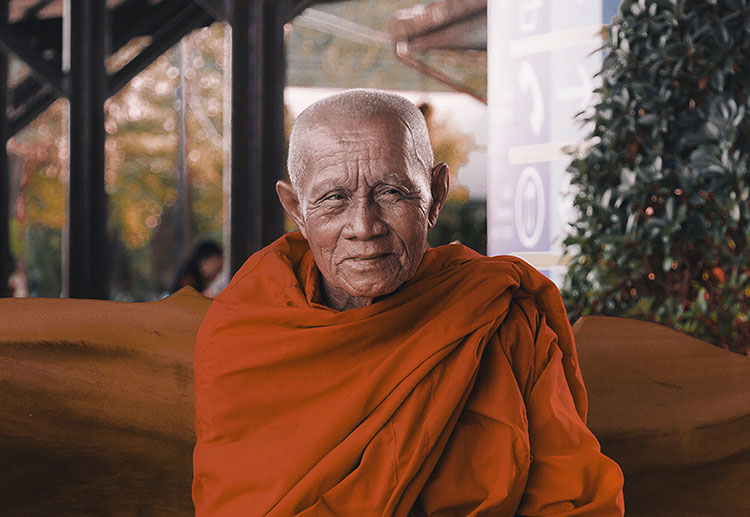
Photo by Quinten de Graaf on Unsplash
The monk speaks to me with his thoughts on life. While being enthralled by each of his words, I decided to tear a piece of paper from this page. I write a question for him. With that question, I rise and decide to approach the monk. The question is about a point from his talk about the possibility that we live multiple lives on Earth. Monks believe in re-incarnation and so the question asked was about “old souls”.
He said that each of us could have carried baggage from a past life. He also said that either of us could have been each other’s brother, mother, or father so why don’t we all treat each other with love and kindness.
Morning Meditation
The meditation today was longer. 40 minutes to be exact. I felt pain—more pain than any time before but as the great monk said pain is not negative just as failure is not negative. He said we must visualize the pain as growth towards a more enlightened self.
Afternoon Walking/Sitting Meditation
I set a goal well I was in the monastery to read the book Autobiography of a Yogi by Paramahamsa Yogananda. Setting out on that goal I was able to see two cultural beliefs parallel at the same time. In experiencing this I wanted to recite something from the autobiography of the yogi.
Mind, nor intellect, nor ego, nor feeling;
Sky, nor earth, nor metals am I,
I am He, I am He, Blessed Spirit, I am He!No birth, no death, no caste have I, Father, Mother, have I none,
I am He, I am He, Blessed Spirit, I am He!Beyond all fancy, formless am I,
Free from dreams of all earthly life,
I am He, I am He, Blessed Spirit, I am He!Bondage I fear not; I’m free in Thy joy! Free! Oh, free, Lord, free in Thy bliss!
I am He, I am He, Blessed Spirit, I am He!
It is Swami’s ultimate goal to be in unity with spirit allowing thy waking and sleeping consciousness to be in the world but not of it.
Oneness…Abundance…Trust…Flow. I am in my element as the rhythm and pace are in unison with the surroundings of nature. With each step of the walking meditation, I am fully here and now. Crossing my legs and focusing inward, I begin the sitting meditation and focus on summertime which is the practice of focusing on one single object. I focus on the cheeseburger ( the number of times I thought of cheeseburgers in southeast asia…can not be counted on two hands ) which leads to ideas of taste, the origin of senses, and thankfulness for food. The rest of the meditation has me in a laser focus on being the knower of my thoughts using the Vipassana technique—observing the thoughts separate from the body.
I am letting go of “I” and replacing it with “I am He.”
During the afternoon break, I choose to pick up leaves around the monastery grounds. I quickly learn leaf cleaning is a form of meditation within itself. I recall being perplexed as I watched older women sweeping on their porches in Bali, Vietnam, and Thailand. There seemed to be nothing to sweep but it was the process of sweeping that they enjoyed. I realize while sweeping that these elderly women had figured out an additional way to practice their devotion to their deity by incorporating sweeping into their daily routine.
As I pick each leaf, I feel bad for taking away the homes and shelter of the bugs from the rain. As crazy as that may sound, I never had the perspective of thinking of something so small needing the leaves for survival. Mind you, I am now four days and 96 hours into being silent. Being silent has allowed me to notice perspectives that would never make it to the surface if I was letting my mind drift into past conversations or what I should say next.
I do my part with leaves not simply because of the ego, not for competition, not for recognition but just because it feels right. This sacred place nestled in the forest gives you a place to stay, feeds you two meals a day, and allows you to immerse yourself in the life of a monk. Doing whatever I can to help the monastery is the least I can do for the beautiful experience they provide for outsiders like me.
Evening Chanting and Night Meditation
Evening chanting seems to arrive quicker than I expected on my way into the meditation hall. I take a small sip of coffee and I enter into the kneeling pose. Chanting is long and arduous. It tests my body and mind as the mind constantly wants to take over. It wants to show its power during these chanting moments. The mind river is vast, it has room for all these thoughts and if I can continue to be the Knower/Observer, I can observe these thoughts while they pass by in simple flow.
Our final praise to Buddha is complete and the transition is made into lotus pose for the last meditation of the day.
I feel somewhat of a breakthrough tonight. The past meditations have culminated in a loss of ego and a deeper connection to something bigger than myself. A sense of accomplishment rushes through me as I reach a high state of mindfulness towards the final moments. It’s hard for me to describe it as an accomplishment, it is more of a big step in the right direction to becoming more mindful. Walking back to my cabin, a mantra or thought enters my awareness. This thought is something that has stuck with me since this experience and I would like to share it with you:
I leaves comparison to others and my past self, I leave expectation of others and my future, and I leave the forceful part of the Ego at the doorstep. For as I walk into this day, I am me, nothing more and nothing less.
Day 5
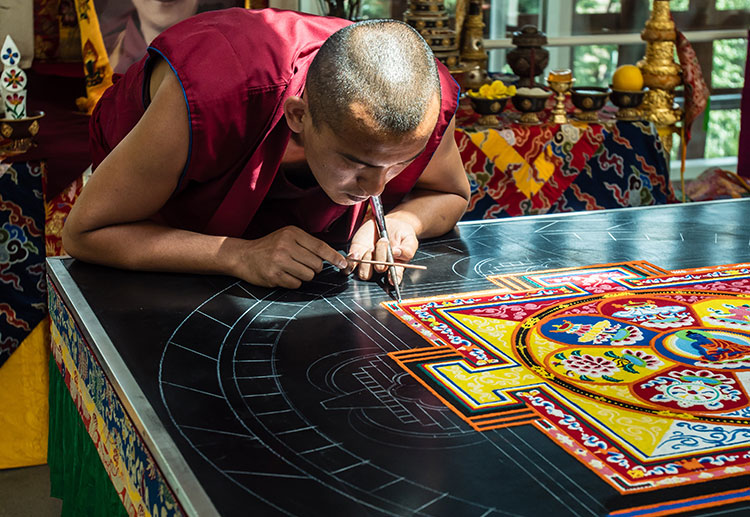
Photo by Jamie Fenn on Unsplash
We go through our usual morning routine and no moments stand out. As the young monk begins his Dharma talk about mindfulness and life he tells of an interesting thought.
When we have connection with one person and spend most of our time with them, we start to gain habits and parts of eachother.
The monk was once a citizen just like you and me. He did internet marketing, had a girlfriend and a very normal life in most people’s eyes. But he said that every waking moment he was free of responsibilities, he dedicated to meditation and continued to try to connect with Buddha with every breath that he had free. He realized all he wanted was to devote the rest of his life to Buddha.
Interlude from the Dalai Lama
Give the ones you love wings to fly, roots to come back, and reasons to stay. – Dalai Lama
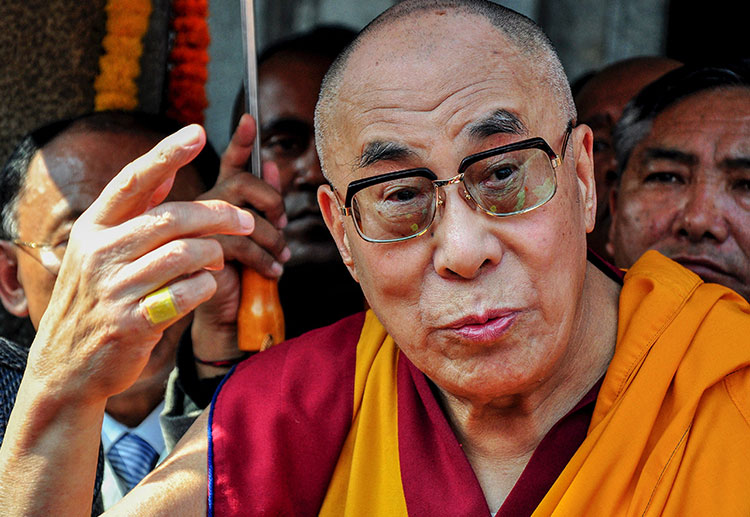
Photo by Norbu Gyachung on Unsplash
Bo the Monk also touched on another very relatable and really interesting concept. He said to take the blue pill don’t take the red pill. The blue pill is awakening, growth. and understanding oneself. You could guess what the red pill is—society, other people’s expectations and not fulfilling your purpose. The monk continues to remind us — time is limited.
The Dharma talk also covered the idea of rebooting. Rebooting is a practice taught by the monks in which if you go with thought and it takes you on a trail to another thought, one must reboot as a computer must reboot. One must come back to our origin of knowing the mind, knowing the thoughts, and not being thoughts.
Learning to Be Flexible
I was quite looking forward to the walking meditation but the rain is starting to pour harder than it has in days. The monks decide we will walk around the Dharma meditation hall. It feels less authentic to walk under a roof instead of out in nature. This is something that I must get used to if I will be able to practice walking meditation back in the real world.
I think being an extremely visual person can get in the way of my presence at times and I realize now that I was overusing my sense of sight. Stimulated by the new sights and nature of South East Asia, I was losing my ability to mind-fully walk. Don’t get me wrong, it was a good distraction to have.
I found my new walking meditation cadence— oneness…abundance…know…flow…right…left…right…left.
Crossing my legs and immersing in lotus pose, I enter the sitting meditation. I am suddenly underwater—deep in a meditative state with water surrounding me. I can hear the sounds of whales overhead and behind me. They are speaking and I don’t understand or see them. I feel them. The water is now underneath me and is flowing like a rushing river. I am on a pedestal as the flow rushes beneath my crossed legs. My breath remains consistent—under and above water.
Afternoon Dharma Class
Before the afternoon meditation, I deep dive back into the Autobiography of a Yogi and the author, Yogananda, says the third eye is opal blue and gold during a meditative state. I realize at this moment that I’ve been seeing an open blue swirl above my closed eyes as I meditate. This space is my third eye and as I continue to work on my practice, it becomes more clear. The monks say that everyone’s energy can be a certain color. Colors of the aura reveal certain aspects of that soul. More to be determined.
Afternoon Walking meditation
I’m beginning to have a breakthrough. I am in the middle of awareness of each step and my surroundings. I am of my body but also not of this body.
Afternoon Sitting Meditation
Great balance between Vipassana and Summertime techniques.
I begin the afternoon meditation with summertime and I focus on the sun. This focus takes me on a tangent to the universal light and the acceptance of us all sharing the same light.
I make the transfer into Vipassana which is becoming less of a struggle at this point. The Observer of my thoughts is what I’m becoming. I no longer feel any pain since pain is a part of a thought and is not within reality. The pain comes and goes just like a thought comes and goes. It is just temporary.
I decide to sweep the leaves and help clean the grounds of the monastery. I find it to be extremely relaxing and enjoyable to the point that I understand the enjoyment someone gets from planting crops, the enjoyment someone gets from farming living off the land or giving back to society. I’d like to do more of this.
Sweeping the leaves is just an extension of one’s daily practice and choice to be mindful. And in being present we can enjoy any moment whether it is sweeping leaves or showing up for the biggest interview of your life.
The evening chat seems longer than ever— seems to get longer every time but instead of looking at it negatively, I see it as a chance to give thanks to Buddha for his teaching. I appreciate the teaching so I show up to every chant and be a part of it to give thanks. I end each prayer with Sadhu which means Amen in Buddhism/Thai.
Evening Meditation
Evening meditation commences and I feel a balance in the summertime technique. My focal point is the rain and how it cleanses our body and the Earth. I transition from summertime meditation into the Vipassana technique. As I focus on each in and out-breath, I begin to feel the sensation of no breath which means I am deep in a meditative state.
Elevated in growth and spirit I am happily seeing progress in my practice.
seek truth in meditation not in moldy books look in the sky to find the moon not in the pond. – Autobiography of a Yogi
Day 6
The morning parallels with the past mornings. As we listen to Bo the Monk, he begins his morning Dharma talk.
Having the full mind versus the intelligent mind. It seems that the dogs at the monastery have the full mind meaning they can’t comprehend anything more than that moment. They can’t think anything more than that moment and their mind becomes full. An intelligent mind is present but not full. It is able to leave space for the moment and to appreciate the moment fully.
One of the dogs consistently sat at my feet during afternoon meditations. He is sweet and calm. He also took part in our walking meditations as he weaved between each walker. He is a monk in his own way.
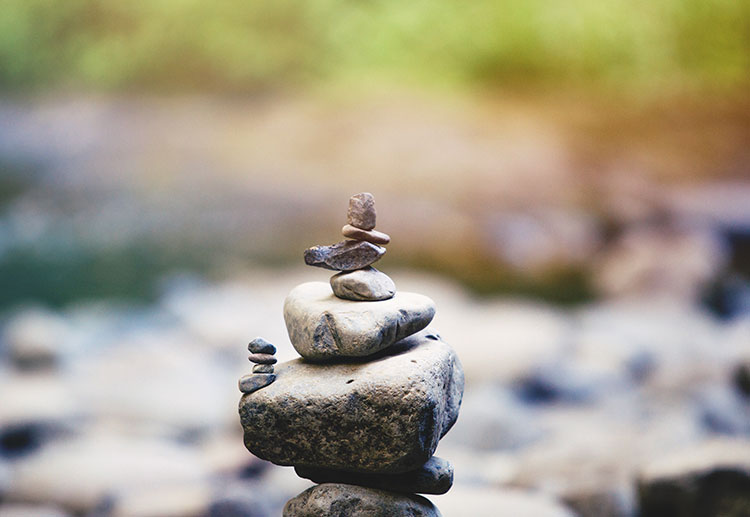
Photo by Austin Neill on Unsplash
The Monk speaks as the Buddha did. He does not want us to follow his teachings and live a replica of his practice. He advises us to learn about all religions and beliefs while keeping an open mind. Then, we can pull pieces and parts of each belief and incorporate it into our own beliefs. Buddha never wanted anyone to see him as a guru or god. His teachings were meant to be mixed with our wisdom. Galileo had wisdom and realized that he could see that the world was round even though society and the collective belief was that it was flat.
Walking meditation
I find my rhythm to the point where I’m doing a slight dance because my rhythm seems to be so in tune with my mind, body, and soul.
Sitting meditation
I’m fully omnipresent to the abundance of the day. In this part of the meditation, I choose to focus on my breathing and 7 chakras. I can feel the flow of light entering from the Universe into my Crown Chakra ( top of the head ).
I also incorporate using my hands and fingers as the object of focus in the summertime technique.
Laying Meditation ( practice after each sitting meditation )
I haven’t touched much on the laying meditation which commences after each sitting meditation because I usually found myself visualizing or passing out. Today, the laying meditation is elevating since the monk has asked us to imagine our death. He wants us to visualize the experience and see if it is a positive/negative death.
I imagine my soul leaving the body and somewhat flying high up into the sky. I do not know how to handle this much freedom from my body. The clouds pass by and my panic turns into pure ecstasy. No longer part of just one dimension, I break through the sky and everything begins to fast-forward. Years turn to minutes, minutes turn to seconds. On the brink of being gone forever, a thought comes over me. Are you ready to leave that life behind just yet?
I am not ready to move on through “death” but I do not fear the idea of this transformation. A so-called death is just smoke n’ mirrors for through my practice, I see no end and beginning— I just see a continued experience as a soul.
Still, in between reality and something else, I mindfully walk away from the Dharma Hall towards my small cabin. I decide this will be my final night at the monastery and I want to see how my meditation goes on my own one time with the temple around me. The evening meditation within my cabin within my inner temple. ( you are asked to attend every part of the schedule each day. I felt so strongly about where I was personally in my development so I decided to forego the evening chanting and evening meditation to practice on my own.)
Just as I enter my room, the rain begins to fall and everyone is within the Dharma Hall starting the evening chant. It’s just me, the rain, and nature. I am extremely enthralled by the rain, it is taking over my senses. I step from the dry stairs and out into the downfall—tongue to the sky. Clothes are now drenched and I impulsively run-up to shelter. But then I have a thought… “No one is around, and I am free to be me!” I pull off my clothes and run out into the rain with only boxers on now.
It feels like months since I last was in a full sprint. I run in rejoice, I run in celebration, I run in acceptance of myself, I run in appreciation for this monastery, and I don’t stop because the smile on my face keeps getting bigger.
Final Night Meditation
I regain my peace as I run back into the cabin. The floor is soaked, I decide to sit on the bed and enter into lotus pose. I find myself in a sense and state of pure gratitude and appreciation. I talked about my longing to stay at a monastery in Southeast Asia for months before leaving America.
Grateful to have been able to manifest this experience, I transition into the Vipassana technique which allows me to fully know and observe my thoughts. The thoughts are less frequent, the volume seems to be at an all-time low. Enthralled with a flow of happiness, I feel the rain from within me pouring down my face. I am finally at home within myself.
“I Can See Clearly Now” – Bob Marley
Opening my eyes, I come to realize that I now have new tools to use in the real world. The monks teach about tending to the garden within us—watering the flowers and cutting the dead weeds. What I feel means more to me now then what I think. Thoughts are quieter and carry less weight since I have learned to lose attachment. I am Christopher Lien, the knower, and the observer of my mind. I am now in the tree with Buddha, there’s room for more. Your experience awaits you.
I fell in love with myself at a Buddhist monastery
Good Meditation Practice I learned from the Monk’s Dharma Talks
A good meditation practice when walking in the park or monastery. Pour a cup of coffee or a glass of water. Now head outside and walk with the glass or coffee. The coffee or glass is your job, career, and materialistic possessions. Nature and the outdoors are your spiritual devotion to your practice. Now if you give nature and your surroundings too much of your attention, the cup will spill. In contrast, if you are unable to answer when asked how it looked outside during your walk, you are too focused on not spilling the cup. This is a practice of finding the balance.
Day 7
back to reality
I plan to leave the monastery as it was when I arrived…peaceful. At the crack of dawn, I awake and hanging my clothes in my cabin, I make my final walk through the grounds. A new dharma hall has been built near the creek so I make my way there to the donation box. I give generously and get back onto the motorbike. The road is dark as the sun has not made it’s way around to this side.
Oneness…Abundance…Know…Flow
I repeat this over and over throughout the entire ride, waving at every passer-by. With about 50 pages still left in the book, I plan to go back to the Pai Hot Springs Resort where I stayed the two nights in Pai prior to the monastery. The plan is to walk back into the resort as if never left. The plan works flawlessly as I wave to the front desk and make my way to the hot springs. I am able to read about 20 pages and the heat becomes unbearable. With no towel in sight, I hang my trunks there for later haha and head over to the restaurant at the resort. I am able to get some coffee and a small breakfast and the waiter asks no questions. I finish the book in the cafe and meet my goal of 7 days.
Now, it’s time to make the ride back down the winding turns towards Chiang Mai. Fast forward to me entering the city. Immediately, I feel the energy of the city. Cars fly by—city sounds blare the peace. I accept this challenge.
Benefits of a Buddhist Retreat for Digital Nomads
All digital nomads have things in common. The main aspect we all share is that our work is done using technology. Whether you are a web designer, social media manager, drone specialist, or pro podcast host, our livelihood depends on our ability to use technology efficiently and effectively.
It’s very easy to get lost in daily tasks. We are being constantly reminded and interrupted by social media notifications, emails, and Whatsapp messages.
Imagine, for a second, taking a break from the hustle and grind. I know, I know, sounds crazy right? You are probably thinking “I can’t stop working right now, I have clients and deadlines to meet.” I get it, I do because I am in the same position as you. But you know what? People tend to acknowledge and approve of someone taking some time to better themselves. My clients handled this very well and were able to see that I would be a better person to work with after this experience. They were envious of the experience.

Photo by Lesly Juarez on Unsplash
Here are the 5 benefits I believe a Buddhist Retreat can do for a Digital Nomad:
- Disconnect from Wi-Fi to reconnect to yourself
- Give yourself a break from the constant grind. You’ll be happy later when you don’t experience burnout.
- Free accommodation and meals each day. This can help validate your self-talk and convince you that this is not only a great life decision but is also a good business decision.
- Clear up space in your mind to have clearer thoughts, plans, and creative output for your clients. If you don’t have clients in your line of work, imagine the space you will clear for new marketing ideas and creativity.
- Get a chance to be a part of the local experience. This is what traveling is all about. Immerse yourself in a culture for a week and learn the ways of the monk.
Conclusion
4 and 1/2 months on the road through South East Asia and I can confidently tell you that my time at the monastery was a bright highlight. One of the most renowned Buddhist monks of our time, Thich Nhat Hanh, is said to speak the words of Buddha. The Heart of the Buddha’s Teaching by Nhat Hanh is a great guide to the teachings of Buddha and a good introduction to Buddhism. From the book…
If we read or listen with an open mind and open heart, the rain of the Dharma will penetrate the soil of our consciousness.
If we touch the truth of suffering with our mindfulness, we will be able to recognize and identify our specific suffering, its specific causes, and the way to remove those causes and end our suffering.”
One of the biggest takeaways from the experience was that suffering is not negative but is vital for growth. It’s hard not to shy away from suffering when our society sees it as a negative sign of weakness. Thich Nhat Hanh channels Buddha in the way he tells us to face our suffering with mindfulness.
Cultivate Real Connections
Habits can be formed very quickly and sometimes we don’t even realize how many hours of the day we spend on social media or binge-watching Netflix. This experience allowed me to see the collective consciousness and to break away from digital “connections” that ended up being meaningless once I left the monastery. I think we all have a deep yearning to return to a more primitive state with real-life connections. Buddha seemed to have this yearning in his own life.
He was once a king and had everything society told him he should want. In the midst of his life, he yearned for more connection to what our eyes can’t see. For years, he challenged his mind, body, and spirit. What he discovered became his teachings.
“My teaching is like a finger pointing the moon. Do not mistake the finger for the moon.”
There is humility in Buddhism beyond all reasonable doubt. Whether you are religious or not, spending 7 days at a monastery will not feel like someone is trying to convert you to anything you don’t want to be. I could not recommend this experience enough to fellow travelers and digital nomads. I continue to practice the lessons and ways of Buddhism that I learned during my time in this monastery. Are you looking for some local outside the box adventures near LA and OC? Click here to start living more in adventure.
Find out the best free places to work from in the near-by nomad hot spot of Chiang Mai.
Tham Wua Forest Monastery
Off the Mae Hong Son-Pai highway, Mae Suya district, Mae Hong Son
T: (081) 031 3326
[email protected]
http://watpatamwua.com/

